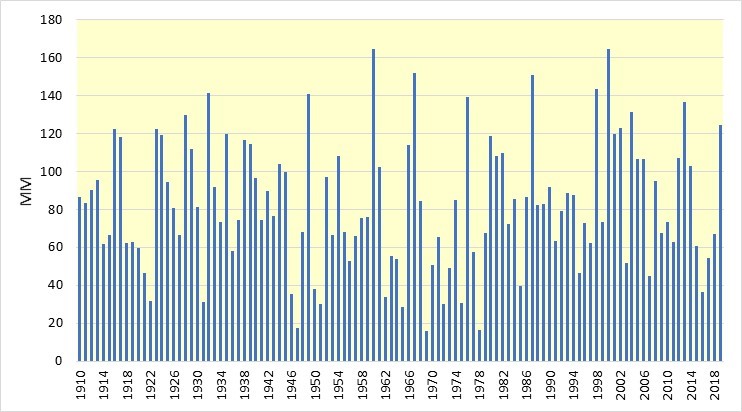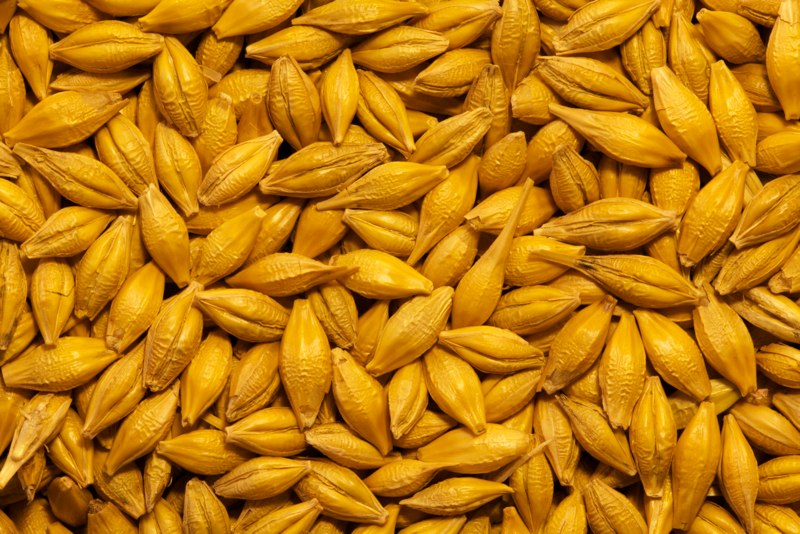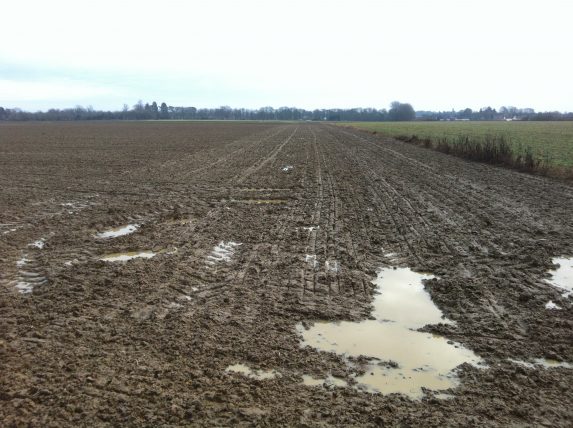Weather Data
The extraordinarily wet autumn has left as much as half of the planned winter wheat area still undrilled at a time of year when we would normally expect over 90% to be completed. Throughout much of the East Midlands, from the heavy soils of Leicestershire to unusually wet Lincolnshire flats, fields as far as the eye can see remain uncultivated. The data from the Met Office does not fully reflect the problems that have been caused. Looking at October rainfall alone in most parts of the UK, the amounts only to a 1 in 13 chance (i.e. this amount of rain has fallen ten times over the last 130 years). It is when you add up the rain from early summer through to now, that it becomes a one in 35-year occurrence. Indeed now, with soils saturated, only a millimetre or two of rain re-saturates the fields again. Many farmers in this region have now gone away from their farms, and plan to return to tackle spring cropping.
UK October Rainfall Statistics from Met Office

Oilseed rape too has suffered from rot, and Cabbage Stem Flea Beetle, which has been worse this year than, it seems, any other. The resolve by many farmers and agronomists not to cultivate OSR in future has been publicly made. Whether we see that promise carried through next year or not we will see, but some will certainly be looking for alternative cropping options.
Europe is also struggling to plant its winter crops, albeit not as much as here in Britain. Strategie Grains has reduced its estimate of EU planted areas for 2020 harvest to less than last year and crop ratings in France have been slipping. Only three quarters of French wheat is drilled so far, compared with 97% in normal years at the end of November.
Early-Bird Crop Area Forecasts
The wet autumn has had clear effects on this autumn’s arable plantings. The AHDB’s Early Bird Survey of cropping intentions for harvest 2020 has just been released and shows a significant drop in winter cereals area. The table below shows a summary of the results. Changes in cropping area have been extrapolated onto the data from Defra’s provisional 2019 UK June Survey to produce forecasted crop areas for the 2020 harvest.
 The wheat area is forecast to fall by 9% which, if correct, would result in 1,645,000ha for harvest 2020, this would be the lowest wheat area since 2013. The spring wheat proportion within total wheat is seen rising a considerable 358%. It is thought that potentially half the UK winter wheat crop is still not planted though, so the decline could end up larger than the survey currently suggests.
The wheat area is forecast to fall by 9% which, if correct, would result in 1,645,000ha for harvest 2020, this would be the lowest wheat area since 2013. The spring wheat proportion within total wheat is seen rising a considerable 358%. It is thought that potentially half the UK winter wheat crop is still not planted though, so the decline could end up larger than the survey currently suggests.
The winter barley area is expected to fall by 12% to about 398,000ha (still higher than 2018), and oilseed rape experiencing a 23% reduction to about 406,000ha. This would be the smallest area drilled since 2002.
The area of spring crops are expected to increase in 2020 and could further rise depending on the next couple of months. Spring barley is anticipated to rise by 28% to 915,000ha, a level not seen since 1988, when over a million hectares was cropped. The survey suggests that the pulse area may rise by nearly a quarter to 221,000ha, almost to levels seen in 2016. This is likely led by spring pulses but it is also noted that winter beans can generally be planted quite late in the season. Unsurprisingly, the fallow area is also thought to be rising (17%).
Other arable crops are all seen rising for 2020. This includes other combinable cereals (up 16%), other oilseeds (up 16%) and other non-combinable crops on arable land (including roots, vegetables, and a proportion of maize and temporary grass crops) (up 5%).
The Early-Bird Survey is undertaken each autumn to assess national cropping intentions. It is carried out by The Andersons Centre with the help of the Association of Independent Crop Consultants (AICC) and other agronomists. Over 80 agronomists took part in this year’s survey contributing over 615,000ha of arable land stratified across all regions of Great Britain.






 The wheat area is forecast to fall by 9% which, if correct, would result in 1,645,000ha for harvest 2020, this would be the lowest wheat area since 2013. The spring wheat proportion within total wheat is seen rising a considerable 358%. It is thought that potentially half the UK winter wheat crop is still not planted though, so the decline could end up larger than the survey currently suggests.
The wheat area is forecast to fall by 9% which, if correct, would result in 1,645,000ha for harvest 2020, this would be the lowest wheat area since 2013. The spring wheat proportion within total wheat is seen rising a considerable 358%. It is thought that potentially half the UK winter wheat crop is still not planted though, so the decline could end up larger than the survey currently suggests.




